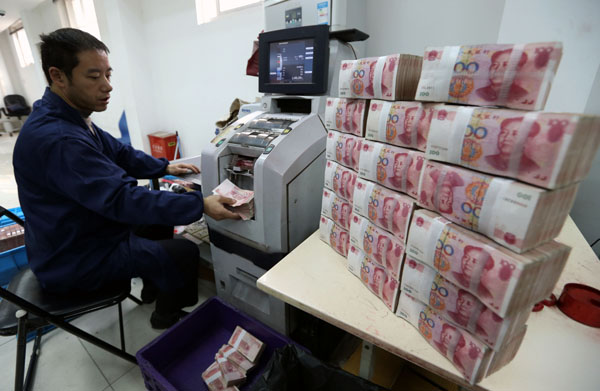New normal to improve living standards
- By Dan Steinbock
 0 Comment(s)
0 Comment(s) Print
Print E-mail China Daily, March 3, 2015
E-mail China Daily, March 3, 2015
China's central bank cut the benchmark deposit and loan interest rates by 25 basis points from Sunday, which has been widely interpreted as an effort to prop up economic growth, which has been slowing.
|
|
|
A bank employee prepares bank notes at an Industrial and Commercial Bank of China Ltd cash center in Wuxi, Jiangsu province. [Photo provided to China Daily] |
The slowing growth in China reflects the demise of the rapid industrialization period, as well as China’s demographic transition. The share of working-age people in the total population has been declining since 2010, while externally growth deceleration reflects slower demand in stagnant Europe and Japan, and recovery in the US. Policymakers were able to keep growth above 7 percent last year, despite the weak investment in real estate and manufacturing, thanks to the government’s “mini-stimulus” and the central bank’s liquidity.
And, despite much pessimistic speculation at home and even more abroad, the government’s annual target of 10 million new jobs was reached by October, well before the year-end.
But what about 2015?
In China, reliable and comprehensive labor market data is still scarce. The official registered unemployment rate has barely moved in the course of the past decade. Although it includes the unemployed that voluntarily register with authorities, it excludes critical segments – rural population, migrant workers and new graduates.
The surveyed unemployment rate, which focuses on labor-age population in large and medium-size cities, provides an alternative picture of the employment trends. It was 5 to 6 percent before the global crisis in 2008 and stabilized at 5 percent, after the government’s huge stimulus package. Currently, it is estimated at 5.1 percent.
Obviously, the government’s stimulus policies and the central bank’s liquidity injections have supported the labor market. Additional easing is to be expected as long as import growth remains sluggish and headline inflation is at a five-year low.
But the labor market is also in a transition, due to the aging population and declining labor force. In the surveyed cities, the demand for labor has exceeded the supply of labor since late 2012. Last year, the demand for labor in cities decreased by 2.2 percent, but the supply of labor plunged by 4.4 percent; twice as much.






